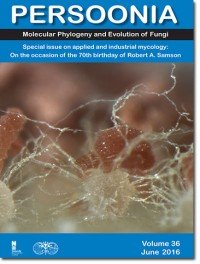Persoonia Q1 Unclaimed
Persoonia is a journal indexed in SJR in Plant Science and Ecology, Evolution, Behavior and Systematics with an H index of 82. Journal with a Single blind Peer Review review system It has an SJR impact factor of 3,037 and it has a best quartile of Q1. It is published in English. It has an SJR impact factor of 3,037.
Type: Journal
Type of Copyright:
Languages: English
Open Access Policy:
Type of publications:
Publication frecuency: -
- €
Inmediate OANPD
Embargoed OA- €
Non OAMetrics
3,037
SJR Impact factor82
H Index13
Total Docs (Last Year)54
Total Docs (3 years)1960
Total Refs521
Total Cites (3 years)54
Citable Docs (3 years)9.61
Cites/Doc (2 years)150.77
Ref/DocOther journals with similar parameters
Annual Review of Plant Biology Q1
Fungal Diversity Q1
Molecular Plant Q1
Mycosphere Q1
Nature Plants Q1
Compare this journals
Aims and Scope
Best articles by citations
<I>Diaporthe</I>: a genus of endophytic, saprobic and plant pathogenic fungi
One fungus, which genes? Development and assessment of universal primers for potential secondary fungal DNA barcodes
New primers for promising single-copy genes in fungal phylogenetics and systematics
Waterborne <i>Exophiala</i> species causing disease in cold-blooded animals
Resolving the phylogenetic and taxonomic status of dark-spored teleomorph genera in the Botryosphaeriaceae
Re-evaluation of <I>Phytophthora citricola</I> isolates from multiple woody hosts in Europe and North America reveals a new species, <I>Phytophthora plurivora</I> sp. nov.
Introducing the Consolidated Species Concept to resolve species in the <I>Teratosphaeriaceae</I>
Fungal Planet description sheets: 214–280
Multiple <I>Didymella</I> teleomorphs are linked to the <I>Phoma clematidina</I> morphotype
Phylogeography and evolutionary patterns in <I>Sporothrix</I> spanning more than 14 000 human and animal case reports
<I>Zymoseptoria</I> gen. nov.: a new genus to accommodate <I>Septoria-</I>like species occurring on graminicolous hosts
Fungal Planet description sheets: 320–370
Unravelling <I>Colletotrichum</I> species associated with <I>Camellia</I>: employing ApMat and GS loci to resolve species in the <I>C. gloeosporioides</I> complex
Fungal Planet description sheets: 469?557
Fungal Planet description sheets: 400–468
Species limits in <i>Diaporthe</i>: molecular re-assessment of <i>D. citri</i>, <i>D. cytosporella</i>, <i>D. foeniculina</i> and <i>D. rudis</i>
Multiple new <I>Phytophthora</I> species from ITS Clade 6 associated with natural ecosystems in Australia: evolutionary and ecological implications
Fungal Planet description sheets: 154–213
Fungal Planet description sheets: 107–127
Unravelling <I>Mycosphaerella</I>: do you believe in genera?
Fungal trunk pathogens associated with wood decay of almond trees on Mallorca (Spain)
Endophytic and pathogenic <I>Phyllosticta</I> species, with reference to those associated with Citrus Black Spot
Stem cankers on sunflower (<i>Helianthus annuus</i>) in Australia reveal a complex of pathogenic <i>Diaporthe</i> (<i>Phomopsis</i>) species
Niche sharing reflects a poorly understood biodiversity phenomenon
View more

Comments